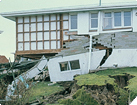Site Analysis
Understanding all the features of a site, using and protecting the best, and minimising the impact of the worst.
Site conditions and ground stability
A thorough investigation and assessment of ground conditions and stability is essential to determine whether a site is suitable for building on, where the best place may be to locate a building and the type and size of foundations that will be required.
Inadequate bearing or ground instability may result in minor or major building failure – if in doubt, seek advice from a structural or geotechnical engineer.
On this page:
- preliminary survey
- bearing pressure
- soil types of insufficient bearing pressure
- water table
- trial holes
- locating information.
Preliminary survey
Carry out a preliminary survey of the site, including consideration of:
- general landforms
- flooding
- evidence of a risk of landslide or subsidence
- evidence of risk of liquefaction
- soil types for load-bearing capacity
- drainage and runoff
- the water table, and presence of natural springs or waterlogged soils
- the proximity of the site or proposed building to excavations or exposed banks
- the presence of expansive clays
- previous use of the site such as buried structures, contamination, earthworks and uncompacted fill.
Bearing pressure
The bearing pressure of soil is its ability to carry the load of the building without excessive settlement (more than 25 mm). Bearing pressure depends on soil type. It must be assessed at the base of the foundations.
Determining good ground
Good ground is defined in NZS 3604:2011 Timber framed buildings as soil that has an ultimate bearing pressure of 300 kPa. The New Zealand Building Code clause B1 Structure also has a definition of good ground. This has been amended and is slightly different from the definition in NZS 3604:2011. It excludes ground at risk from liquefaction and lateral spreading from the definition of good ground. This is the definition that should be followed.
Evidence of good ground includes where:
- foundations of adjacent buildings show no signs of settlement or inadequate bearing
- there is no evidence of landslides in the vicinity
- there is no evidence of buried services
- there is no organic soil, peat or soft clay.
Testing with a Scala penetrometer can help to establish good ground, but other investigations must be employed too, such as checking the council PIM report and other records and maps.
If the ground does not meet the bearing pressure from the penetrometer test or the building is outside the scope of NZS 3604, the ground condition must be assessed by a geotechnical or soil engineer.
Soil types of insufficient bearing pressure
Soil types that have insufficient bearing pressure include peat, sand and expansive clay.
Peat
Peat occurs in low-lying areas and consists of compressed dead vegetation that has been preserved from decay by acidic groundwater. Although the surface of the ground can appear stable and dry, peat may be present below the surface in a deep layer that will compress under the weight of a building.
If the presence of peat is suspected, consult a soil engineer. The extent and depth of the peat will need to be determined by drilling bore holes. Where there is only a thin layer of peat, it may be able to be removed to expose firmer soil below. Alternatively, a specifically designed raft foundation and floor slab may be needed.
Sand
Sands vary in particle size and in compaction, and some types of sand have low bearing capacity. If the soil type is sand, piles driven down to a good bearing layer may be required in conjunction with a concrete slab.
Expansive clay
Expansive clay increases significantly in volume when wet and shrinks again when dry.
When expansive clay extends a significant depth below the surface and particularly if it occurs at a depth where the water level fluctuates, substantial uplift of the ground’s surface may occur during wet periods, followed by subsidence during a dry periods. The amount of uplift will vary according to the clay content of the soil but may be up to 50 mm.
Building on a clay soil will affect the ground moisture content and result in a different pattern of expansion and contraction. Moisture content will also be reduced by large paved areas, tree planting and subsoil drainage.
If expansive clay is present, consult a structural or geotechnical engineer
Fill
If the building site contains areas of fill, whether excavated and relocated on the site or imported from another location, it must comply with NZS 4431:1989 Code of practice for earth fill for residential development. This 1989 version is deemed to comply with the Building Code. A new edition of the standard published in 2022 can be used as part of an alternative solution to demonstrate Code compliance.
Tests must be carried out to determine the bearing capacity of the fill. Generally, fill is unlikely to meet the required bearing capacity so foundations must pass through the fill down to solid bearing below.
Water table
A high water table means the water pressure in the soil is high and that the soil is likely to be correspondingly weaker. High water pressure will also adversely affect the stability of sloping ground and increase the loading on a wall retaining the sloping ground.
If the building site is surrounded by areas of higher ground, underground water will tend to flow to the site. This may cause pressure beneath a concrete floor slab or increased moisture levels beneath a timber floor. It can also cause water to be driven into timber piles. In this situation, subsoil drainage may be necessary.
Indications of a high groundwater table include:
- reeds or other wet area vegetation
- surface water or boggy ground
- springs.
A high water table is likely to mean the construction will be more difficult, and it may be necessary to pump excavations and provide drainage to remove the water, which will generally result in additional costs.
Trial holes
Information about the history of the site from documen/ay confirm that a site has subsoil suitable for the proposed building work, but if there is doubt about good bearing, trial holes must be dug from which to take soil samples at lower levels.
When digging trial holes, record the:
- date of excavation
- location of hole on the site
- relative level of hole if the ground is not flat
- overall dimensions and depth of hole
- excavation system used
- ease of excavation
- rainfall that occurred while the holes were being dug
- groundwater conditions and water table level (if found)
- soil descriptions and depth of each layer
- positions from which samples were taken.
If the proposed building is low rise, trial holes may be dug by a mechanical back hoe or by hand.
During digging, the sides of the excavations must be supported so the hole can be entered safely to take samples. On completion of soil sampling, backfill the trial hole by compacting the material in 150 mm layers so that future work in the area will not be affected.
Locating information
Obtain information about ground conditions from local and regional councils, a PIM/LIM and/or a site visit. Many local councils have developed online maps showing locations at risk from hazards such as flooding, sea level rise, erosion, landslides or liquefaction.
If there any are doubts about ground stability, consult a geotechnical engineer.
The MBIE document Practice Advisory 17: Well-planned ground investigations can save costs points out that some poor building performance in the Canterbury earthquakes was the result of inadequate site investigations. It describes site investigation aims and strategy, and points out how an appropriate strategy can actually save money overall.
Updated: 25 July 2022


